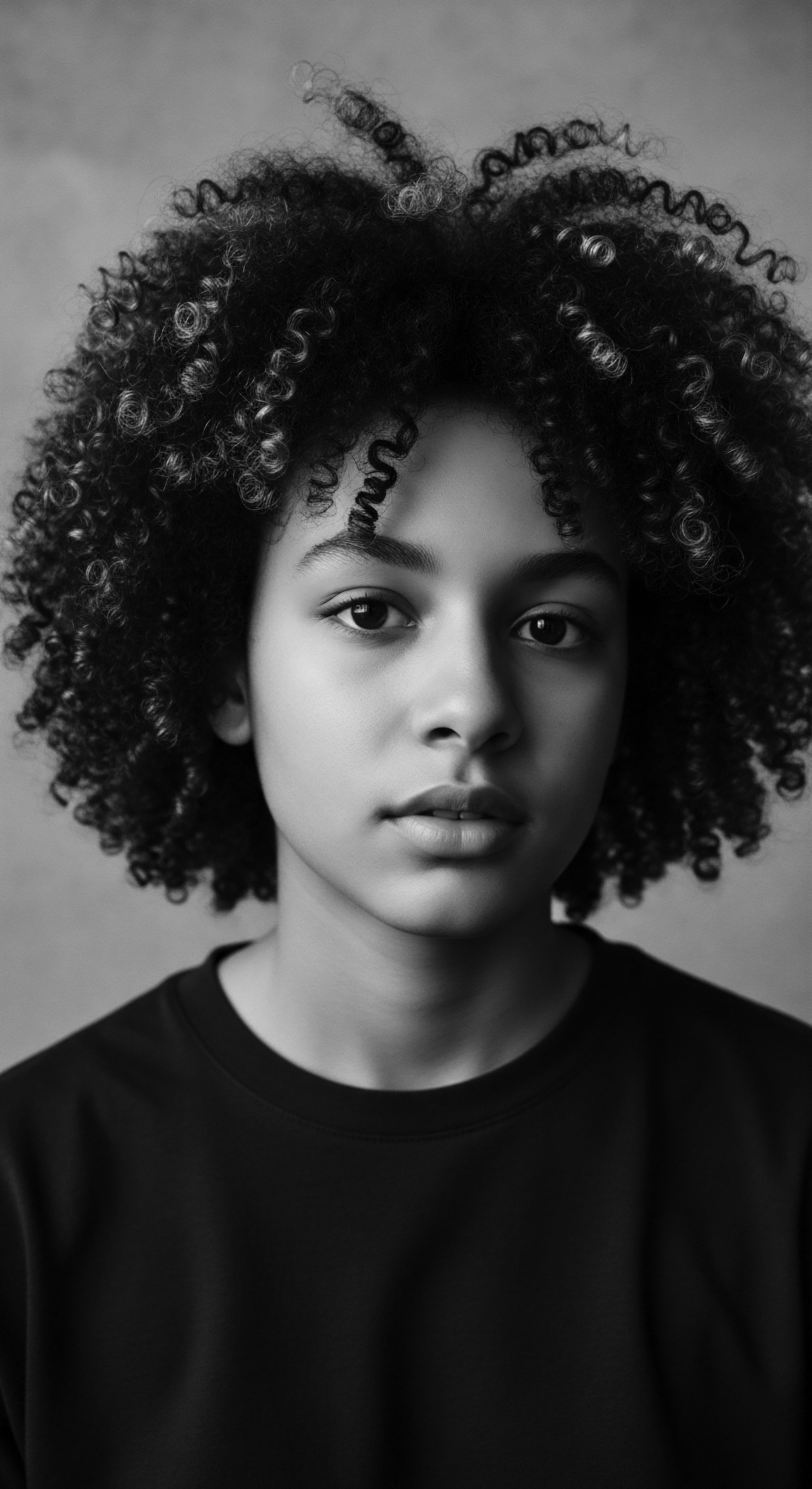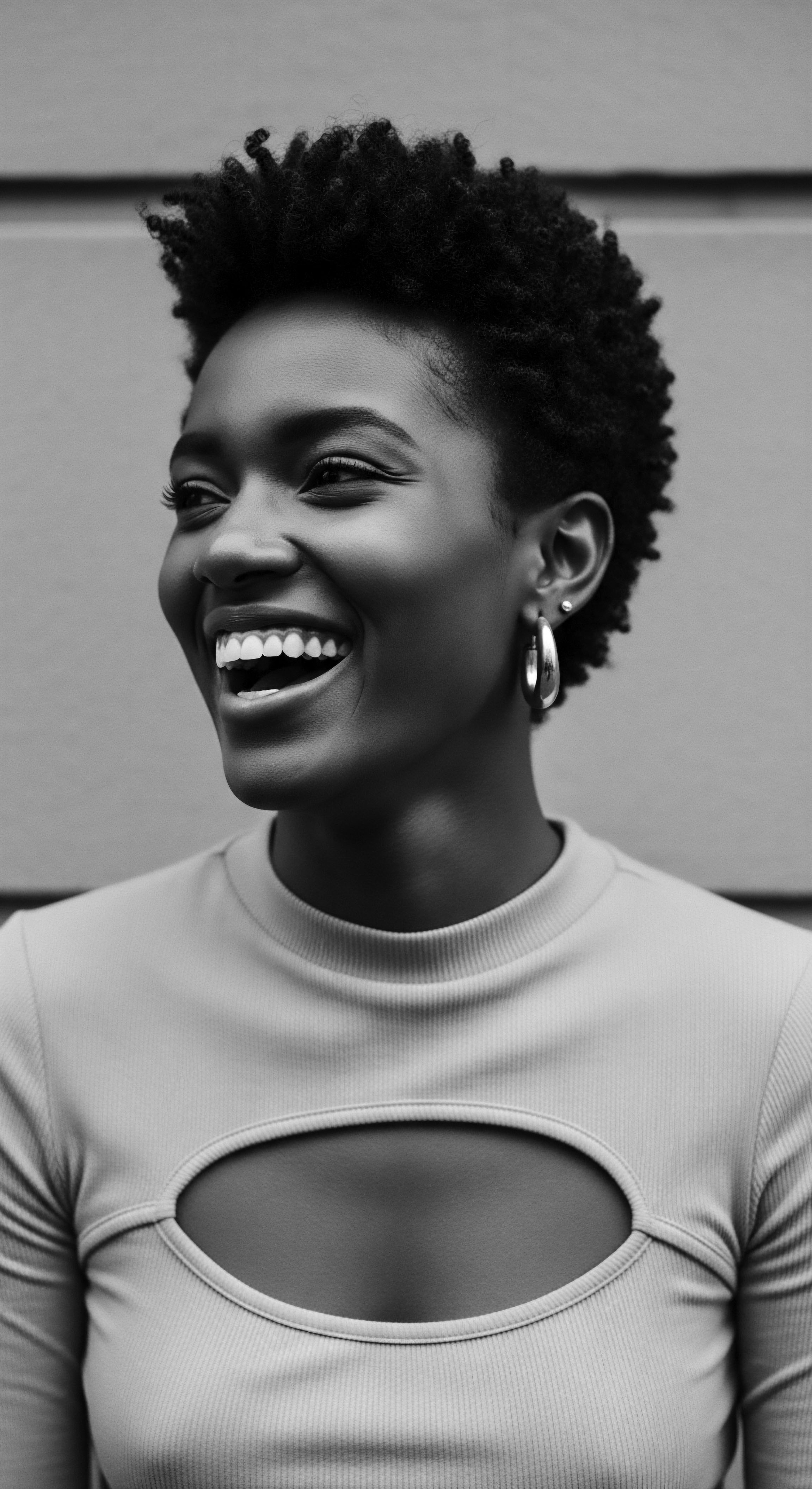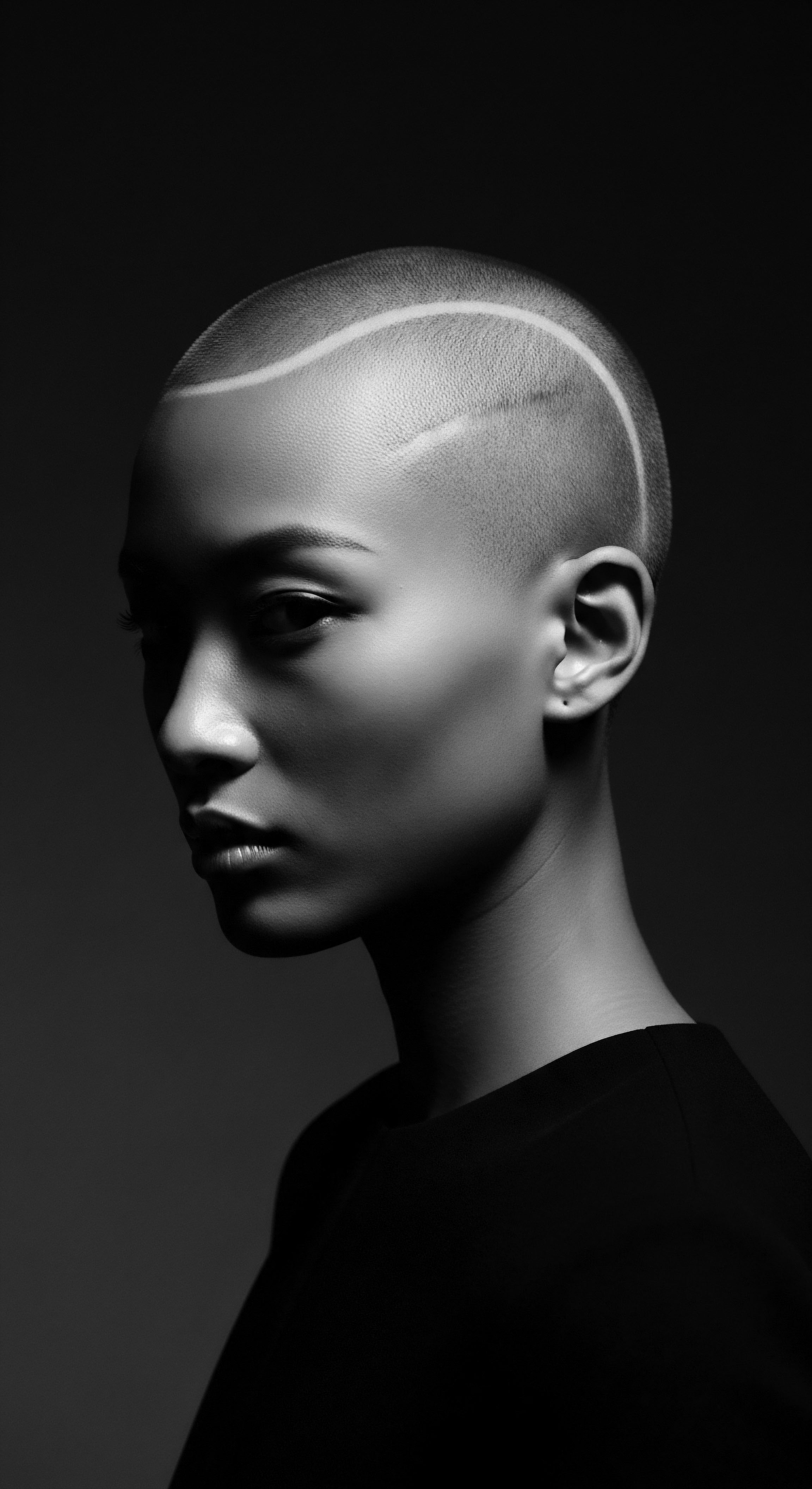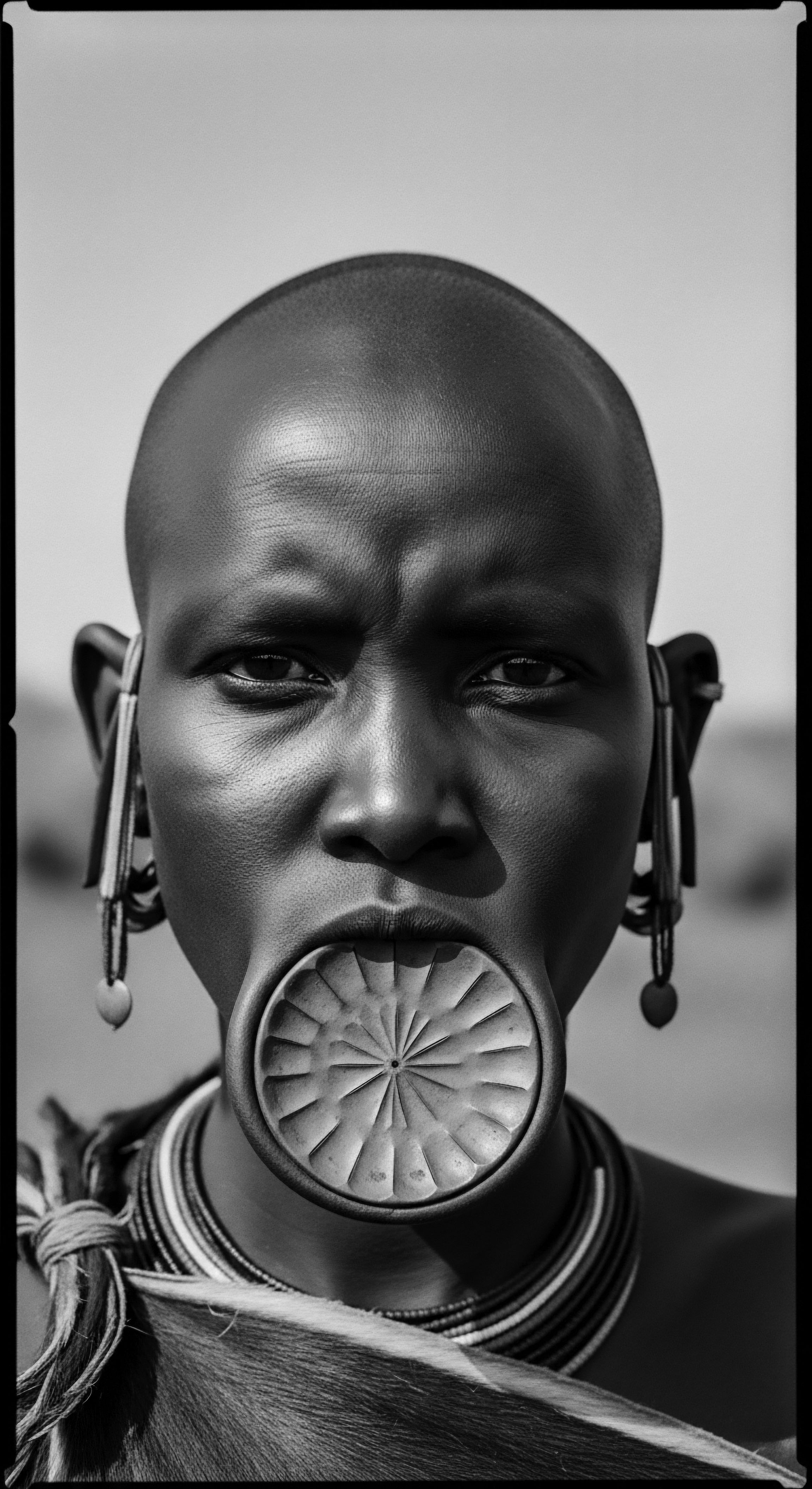
Fundamentals
The concept of ageism in beauty, in its most accessible meaning, speaks to the prejudice or discrimination directed against individuals based on their age, specifically manifesting within the aesthetic realm. It is a societal inclination that often prioritizes youthful appearances, implicitly and explicitly devaluing or dismissing the beauty that accompanies the passage of years. This orientation extends beyond simple aesthetic preference; it intertwines with assumptions regarding competence, vitality, and societal worth, creating a framework where visible signs of aging are frequently regarded as something to be concealed or corrected.
Within the context of textured hair, especially for those of Black and mixed-race heritage, the roots of ageism in beauty run particularly deep, entwining with historical and cultural narratives of identity and self-acceptance. Hair, for these communities, has always been a profound marker of lineage, status, and personal expression. The way it has been perceived through generations, and the standards imposed upon it, often reflect broader societal attitudes towards age and appearance. The fundamental definition of ageism in beauty, therefore, must account for these layered historical burdens, recognizing that the devaluation of aged hair is not merely a modern marketing ploy, but an echo of long-standing biases.
Ageism in beauty, when viewed through the lens of textured hair heritage, reveals a societal bias that devalues the inherent splendor of aging tresses, often dismissing the wisdom and stories they carry.
Understanding the basic tenets of this concept requires an acknowledgment that beauty is a fluid construct, shaped by time, place, and cultural imperatives. When a society begins to declare certain ages as less beautiful, or less desirable, it enacts a form of structural marginalization. For textured hair, this often translates into a neglect of hair care practices that honor the changes of aging hair, such as shifts in texture, density, or color, in favor of methods that attempt to maintain a perpetual youthful appearance. This overlooks the elemental biology of aging hair, treating natural processes as defects requiring intervention rather than phases deserving of respect and specialized care.
Consideration of ageism in beauty is an invitation to question prevailing narratives and to appreciate the unique beauty of every life stage. It moves us to look beyond superficial ideals and recognize the dignity and intrinsic beauty that emanates from a lifetime of experiences, visibly etched in the very strands of one’s hair.

Intermediate
Moving into a more intermediate understanding, the meaning of ageism in beauty expands to encompass its systemic nature and the pervasive influence it exerts on perceptions of self-worth and communal belonging, particularly for individuals with textured hair. This concept delineates how societal structures, commercial interests, and cultural norms conspire to diminish the value of older appearances. The implication is often a tacit instruction that one must strive to appear eternally youthful to remain relevant or seen within beauty discourse. For Black and mixed-race communities, whose hair has consistently been a battleground for identity and acceptance, this pressure takes on added historical weight, resonating with past struggles for self-definition against imposed standards.
The description of ageism in beauty, at this level, recognizes that it often manifests in two primary forms ❉ the social obsession with youthfulness and overt discrimination against older adults based on their appearance (Levy et al. 2021). Within textured hair communities, this dual aspect has played out through generations.
The hair care industry, historically dominated by Eurocentric ideals, has frequently marketed products that promised to “tame” or “straighten” textured hair, often equating these alterations with a more “presentable” or “youthful” look. As individuals aged, this pressure intensified, urging them to conceal grey strands or to maintain textures that might diverge from their hair’s natural aging trajectory.
An interpretation of ageism in beauty in this context involves examining the subtle and overt ways traditional beauty standards have been applied to aging hair. For instance, while grey hair might be celebrated as “distinguished” on some hair types, particularly within dominant Western narratives for men, it has often been associated with decline or unkemptness for women, especially for those with textured hair. This is particularly striking when juxtaposed against traditional African societies where grey hair often symbolized wisdom, status, and profound experience.
The prejudice of ageism in beauty distorts the true significance of aging textured hair, detaching it from its ancestral associations with wisdom and deep-rooted knowledge.
The clarification here extends to how the industry has historically overlooked or misaddressed the specific needs of aging textured hair. As hair ages, its protein structure, moisture retention, and elasticity can change, sometimes leading to increased fragility or alterations in curl pattern. Rather than developing care rituals that honor these natural shifts, the market has often leaned towards “anti-aging” solutions that suggest a problem to be solved rather than a natural evolution to be supported. This creates a dissonance between elemental biology and commercially driven ideals, which disproportionately affects communities whose hair structure already possesses unique needs.
Moreover, ageism in beauty also has consequences for representation. When older individuals, especially older Black and mixed-race women with their authentic textured hair, are rarely featured in mainstream beauty campaigns, it sends a clear message about whose beauty is deemed worthy of visibility. This absence perpetuates a cycle where younger generations internalize that their hair’s natural progression may lead to invisibility, thereby intensifying the pressure to adhere to youth-centric standards for as long as possible. The meaning here extends to the collective psychological well-being, where external validations of beauty are intrinsically tied to an ageist framework.

Historical Echoes in Textured Hair Care
Exploring the historical trajectory, one discerns that the journey of textured hair through various eras has been intricately linked to evolving beauty ideologies, many of which subtly or overtly contained ageist undercurrents.
- Colonial Influences ❉ During the transatlantic slave trade and its aftermath, enslavers imposed strict grooming regulations, often shaving heads or forcing coverings, which served to strip identity and communal markers. This early systematic dismantling of ancestral hair traditions contributed to a foundational trauma that later manifested in beauty standards. As a result, the very act of maintaining traditional, age-old styles was often associated with resistance or a lack of assimilation, thereby indirectly marking them as less desirable in a Eurocentric beauty hierarchy that privileged youth and straightened textures.
- Post-Emancipation Adaptations ❉ The post-emancipation era saw a persistent drive for assimilation, where straightened hair became a means of perceived social and economic advancement. This movement, while offering some avenues for survival, also subtly embedded ageist implications. Younger generations, seeking opportunity, might adopt chemical straighteners or hot combs, distancing themselves from the natural, sometimes grey, textures of their elders, who had maintained more traditional approaches out of necessity or inherited wisdom (Byrd & Tharps, 2014). This created a generational divide in hair practices, with the “modern” and “youthful” often favored over the “traditional” and “aged.”
- The Civil Rights Era and Beyond ❉ The “Black is Beautiful” movement of the 1960s presented a profound counter-narrative, celebrating natural textures as symbols of pride and political identity. This period offered a respite from the direct imposition of Eurocentric standards, yet even then, the natural hair movement often centered on the vibrancy of youthful Afros, sometimes inadvertently leaving older, naturally aging textures in a less visible space. The collective joy in reclaiming kinks and coils was powerful, yet the representation of aging natural hair continued to be a slower-unfolding narrative.
The collective consciousness of these communities holds the echoes of these periods. An intermediate examination of ageism in beauty necessitates understanding how these historical forces continue to shape contemporary attitudes, influencing product development, media portrayals, and individual hair care choices. The goal remains to move towards a more inclusive and reverent understanding of beauty that honors every phase of life and every texture of hair, irrespective of age.

Academic
From an academic perspective, the Ageism in Beauty constitutes a complex socio-cultural construct, deeply intertwined with systems of power, historical oppression, and the commodification of appearance. Its scholarly delineation moves beyond simplistic notions of chronological bias, instead interpreting it as a multifaceted phenomenon that systematically marginalizes, devalues, and renders invisible individuals whose appearances deviate from a youthful, often Eurocentric, aesthetic ideal. For communities with textured hair, particularly those of Black and mixed-race ancestry, this definition gains additional layers of critical inquiry, as the intersection of race, gender, and age has shaped beauty mandates in distinct and often damaging ways.
The meaning of Ageism in Beauty within this academic lens involves a critical examination of how dominant societal narratives enforce a chronological hierarchy of beauty, where youth is positioned as the pinnacle of desirability. This systemic bias is not merely a superficial preference; it serves to uphold a capitalist framework that profits from insecurity, driving consumption of “anti-aging” products and procedures. When applied to textured hair, this often translates to a pressure to chemically alter or conceal natural signs of aging, such as greying or thinning, rather than embracing the hair’s natural progression. This is particularly noteworthy given the historical context where textured hair was already subjected to intense scrutiny and discrimination based on its natural form, often deemed “unprofessional” or “unbeautiful” if not altered (Byrd & Tharps, 2014; Johnson, 2021).
The academic interpretation of ageism in beauty unveils a system where aging textured hair becomes a site of intersectional marginalization, demanding a re-evaluation of inherent worth beyond fleeting ideals.
A comprehensive exploration necessitates considering its manifestation across various fields:
- Sociological Implications ❉ Ageism in beauty contributes to the social invisibility of older individuals. Research indicates that women, more than men, are routinely judged based upon their physical appearance, and mainstream beauty standards strongly prescribe a youthful presentation (Hurd Clarke et al. 2009). For Black and mixed-race women, this is compounded by racialized beauty standards. The intersection means that older Black women with naturally greying, coily hair may face a double marginalization, being deemed less visible not only because of age but also because their hair texture and color challenge Eurocentric norms of “graceful aging” (Johnson, 2021). This impacts self-esteem and psychological well-being, as external validation from a youth-obsessed society diminishes with age.
- Cultural Production and Media Representation ❉ The media plays a significant role in perpetuating ageist beauty ideals. Older women, especially those of color, are vastly underrepresented, or when depicted, they are often shown conforming to youth-centric standards through cosmetic alterations (Szarabajka, 2024; Johnson, 2021). This lack of authentic representation reinforces the idea that visible aging is undesirable, creating a feedback loop where societal expectations dictate media portrayals, which in turn shape individual perceptions. For textured hair, this translates to an absence of images celebrating naturally silvering coils or mature locs, contributing to a sense of unworthiness for those who bear these natural signs of life lived.
- Psychological Well-Being and Internalized Ageism ❉ The constant exposure to ageist beauty standards can lead to internalized ageism, where individuals adopt society’s negative views about aging. This may result in feelings of dissatisfaction with one’s body and hair, prompting expensive and potentially harmful interventions. Studies exploring age discrimination and body esteem among older women, including African American women, suggest that perceptions of age discrimination are tied to psychological distress (Levy et al. 2021; Sabik, 2015). While body esteem partially mediates this distress for European American women, the mechanisms for African American women may differ, pointing to unique cultural and historical factors at play (Sabik, 2015). This suggests that the legacy of racialized beauty standards interacts with ageism in ways that require deeper, culturally attuned psychological support.
To anchor this exploration in a specific historical context, we consider the nuanced understanding of grey hair within traditional African societies contrasted with its perception under the influence of Eurocentric beauty mandates. In many pre-colonial African communities, the appearance of grey hair, often referred to as “silver threads of wisdom,” was not merely tolerated but revered. It was a tangible sign of longevity, experience, and proximity to ancestral knowledge, signifying elevated social status, deep understanding, and a respected place within the community hierarchy (AFRICAW, 2021; Africa.com, 2022; Ojo, 2006).
Elders with grey hair or beards were often seen as repositories of collective memory and spiritual insight, their appearance commanding innate deference. This view is well documented in historical and anthropological accounts, where elaborate coiffures on elders often incorporated these silver strands as symbols of distinction (Sieber & Herreman, 2000; Ojo, 2006).
| Community/Region Yoruba (West Africa) |
| Hair Practice/Significance Hair as an elevated part of the body, intricate braided styles. |
| Age-Related Cultural Connotation Braided hair was used to send messages to the gods, a practice often associated with communal wisdom and elders. |
| Community/Region Himba (Namibia) |
| Hair Practice/Significance Otjize mixture (ochre, butter, goat hair) applied to locs. |
| Age-Related Cultural Connotation Hair indicates age, life stage, and marital status; elder women's styles convey experience. |
| Community/Region Many pre-colonial African societies |
| Hair Practice/Significance Elaborate styles, sometimes incorporating grey strands. |
| Age-Related Cultural Connotation Grey hair signifies wisdom, status, and proximity to ancestral knowledge, demanding respect. |
| Community/Region These examples highlight a deep-seated respect for the aging process and its visual markers, starkly contrasting with Western ageist beauty norms. |
This traditional reverence provides a powerful counter-narrative to the prevailing ageism in beauty, particularly as it pertains to textured hair. With the advent of colonialism and subsequently, the transatlantic slave trade, there was a deliberate and systematic effort to strip enslaved Africans of their cultural markers, including their elaborate hair practices and the honor associated with them (Byrd & Tharps, 2014; Johnson, 2021). Hair that was kinky or coily was derided as “bad” or “unmanageable,” and straight hair, often achieved through painful chemical treatments or hot combs, became the imposed standard of desirability and professionalism (Wilcox, 2017). This shift initiated a profound cultural violence against indigenous beauty ideals (Oyedemi, 2016), laying the groundwork for a beauty hierarchy that would naturally privilege youth and Eurocentric traits.
The specific connection to ageism in beauty within this historical lineage is acutely observed in the marketing of hair dyes and relaxers to Black women. While hair coloring has existed across cultures for centuries, the emphasis on obscuring natural grey hair in Black communities often stemmed from a colonial beauty standard that actively conflated youth with beauty and systematically devalued the profound understanding traditionally associated with age. Post-WWII, as chemical dyes and relaxers became widely available and aggressively marketed, a narrative of “anti-aging” gained widespread adoption, subtly compelling elder Black women to maintain a youthful façade through altered hair color and texture to retain visibility or be considered “beautiful” within prevailing societal paradigms (Byrd & Tharps, 2014; Johnson, 2021). This created an insidious pressure that severed many from ancestral wisdom that honored the natural silvering process as a badge of honor, instead pushing them towards continuous chemical treatments.
The long-term consequences of this systemic Ageism in Beauty are significant. Firstly, it contributes to the continued marginalization of elder voices and experiences within the beauty sphere, reinforcing a narrow, transient standard of attractiveness. Secondly, it can lead to health implications, as the continuous use of harsh chemical treatments to maintain an unnatural youthful appearance can damage both hair and scalp (Wilcox, 2017).
Thirdly, it perpetuates a psychological burden, as individuals internalize the message that their natural aging process is something to be fought or hidden, rather than celebrated. The success of the contemporary natural hair movement, a “second wave” of reclaiming authentic hair textures, stands as a testament to the ongoing resistance against these imposed standards, though scholars note an underdeveloped analysis regarding older Black women’s hair transitions within this movement, and its implications for ageism (Johnson, 2021).
The scholarly definition of Ageism in Beauty, therefore, cannot be truly complete without understanding its specific and profound impact on textured hair heritage. It compels us to recognize that addressing this form of bias requires not just a shift in marketing campaigns, but a deep cultural recalibration that honors the profound beauty of every stage of life and the inherent value of ancestral practices that understood hair not just as an aesthetic adornment, but as a living legacy.

Reflection on the Heritage of Ageism in Beauty
As we close this dialogue on Ageism in Beauty, a quiet truth settles upon the spirit ❉ the journey of textured hair is, at its heart, a saga of enduring heritage and resilience. Each coil, kink, and wave, whether jet black or touched with silver light, carries the whispers of ancestors, bearing witness to traditions of care, communal bonds, and fierce declarations of identity. The shadow of ageism, with its relentless pursuit of an ephemeral youth, has attempted to dim this ancient glow, suggesting that the natural progression of years diminishes inherent beauty. Yet, the story of our hair, particularly in Black and mixed-race communities, resists such narrow definitions.
Consider the hands that first oiled and braided hair beneath ancestral skies, imbuing each strand with purpose and spirit. These were often the hands of elders, their wisdom etched in their very being, their silvering crowns symbols of profound understanding. The contemporary push to conceal grey hair, to chemically alter textures that soften with age, often represents a stark departure from this revered lineage. It is a societal narrative that seeks to unravel the tender thread connecting us to practices where age meant not decline, but rather an accumulation of grace and insight.
The profound meaning embedded within the “Soul of a Strand” urges us to listen closely to the stories our hair tells. It speaks of the earth from which we arose, the rituals that sustained us, and the innate strength that flows through generations. To accept and cherish textured hair at every age, through every shift in its structure or hue, is an act of reclamation. It is a quiet rebellion against a system that seeks to dictate worth based on fleeting aesthetics.
Such an embrace allows us to witness the unbroken lineage of care and cultural significance that binds us to our past, providing a wellspring of fortitude for our present and a guide for our future. The unbound helix of our hair, ever-evolving, yet eternally rooted, stands as a testament to beauty’s timeless, boundless nature.

References
- AFRICAW. (2021). Elders and the wisdom of the Gods.
- Byrd, A. D. & Tharps, L. L. (2014). Hair Story ❉ Untangling the Roots of Black Hair in America. St. Martin’s Griffin.
- Hurd Clarke, L. Griffin, M. & Maliha, S. (2009). Ageism and Body Esteem ❉ Associations with Psychological Well-Being Among Late Middle-Aged African American and European American Women. The Journals of Gerontology Series B ❉ Psychological Sciences and Social Sciences, 64B(5), 557–566.
- Johnson, C. M. E. (2021). Black Beauty and the Politics of Hair. Oxford University Press.
- Levy, S. R. Lytle, A. Monahan, C. & Apriceno, M. (2021). Ageism-Reduction Programs. In The Psychology of Ageism (pp. 235-259). Academic Press.
- Ojo, G. J. A. (2006). Yoruba Culture ❉ A Geographical Analysis. Longman Nigeria.
- Oyedemi, T. (2016). ‘Beautiful’ hair and the cultural violence of identity erasure. Communicatio, 42(3), 390-406.
- Sabik, N. J. (2015). Ageism and Body Esteem ❉ Associations With Psychological Well-Being Among Late Middle-Aged African American and European American Women. The Journals of Gerontology, Series B, Psychological Sciences and Social Sciences, 70(2), 189–199.
- Sieber, R. H. & Herreman, F. (Eds.). (2000). Hair in African Art and Culture. Museum for African Art.
- Szarabajka, W. (2024, April 24). Granny? More Like Mommy ❉ The Prevalence of Ageism in Beauty. Hopkins School.
- Wilcox, A. (2017). Femininity, Hair Relaxers, and the Impact of Beauty Standards on Black Women’s Health. Inquiries Journal, 9(10).
